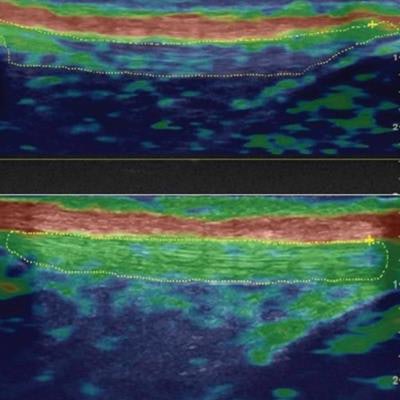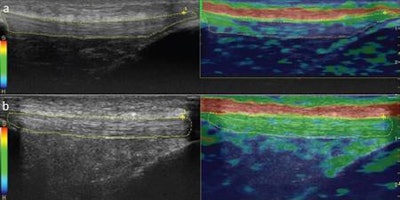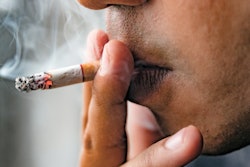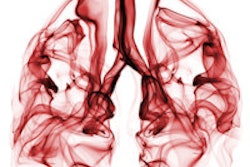
Need another reason to quit or never start smoking cigarettes? B-mode ultrasound and elastography show that smoking can negatively affect the patellar and Achilles tendons, according to research published in the November issue of the Journal of Ultrasound in Medicine.
After scanning nearly 70 healthy volunteers with B-mode ultrasound and ultrasound elastography, a research team in Turkey found that smokers had thinner and stiffer patellar and Achilles tendons than those who did not smoke.
"Our first and preliminary findings imply that smoking adversely affects the patellar and Achilles tendons (i.e., causes thinning and decreased elasticity) in otherwise healthy smokers," said co-author Dr. Nuray Akkaya, an associate professor at Pamukkale University Medical School in Denizli.
Smoking and tendons
While the relationships between cigarette smoking and tendinopathy, rotator cuff tears, and postoperative delayed healing are well-known in the medical literature, its effects on the mechanical properties of otherwise healthy tendons in smokers have not been investigated substantially, Akkaya said.
 Dr. Nuray Akkaya from Pamukkale University Medical School.
Dr. Nuray Akkaya from Pamukkale University Medical School."Therefore, in this study we aimed to explore the in vivo effects of smoking on the morphological and mechanical features of patellar and Achilles tendons with [ultrasound] elastography, which allows objective evaluation of tissue elastic properties (tissue strain) relative to reference tissues," she told AuntMinnie.com.
The researchers enrolled 69 volunteers with a mean age of 35.5 ± 7.8 years; there were 57 men and 12 women. The volunteers were divided into two groups: 34 nonsmokers, who said they had never smoked in their lives, and 35 smokers, who said they had smoked for at least 12 months. The groups had similar demographics (J Ultrasound Med, November 2016, Vol. 35:11, pp. 2431-2438).
All ultrasound exams were performed by one radiologist on a Logiq E9 ultrasound scanner (GE Healthcare) with 7- to 13-MHz linear transducer. The radiologist was blinded to the smoking status of the volunteers. B-mode sonography was used to measure the proximal, middle, and distal third thicknesses of the patellar and Achilles tendon.
Real-time ultrasound elastography was also performed on the same regions to calculate strain ratio measurements. The scanner's software calculated the strain ratio measurements, coded the tissue strain in the selected region of interest on a scale between 1 (softest tissue, greatest strain) and 6 (hardest tissue, no strain), and then color-coded tendons based on elastographic patterns at the three measurement sites (grade 1, blue: hardest tissue; grade 2, blue/green: hard tissue; and grade 3, green: intermediate tissue).
There were also three additional color-coded subgrades -- subgrade a, no red coloring: homogeneous; subgrade b, parallel red stripes along the length of the tendon: relatively homogenous; and subgrade c, patchy distribution of color codes on the dominant tendon pattern: heterogeneous.
Thinner, thicker tendons
All three areas of the patellar and Achilles tendons were significantly thinner in the smoking group, the researchers found.
| Tendon thickness by smoking status | |||
| Nonsmokers | Smokers | p-value | |
| Patellar tendon thickness (mm) | |||
| Proximal third | 4.3 ± 0.4 | 4.1 ± 0.4 | 0.022 |
| Middle third | 4.3 ± 0.4 | 4.1 ± 0.4 | 0.021 |
| Distal third | 4.3 ± 0.4 | 4.1 ± 0.4 | 0.018 |
| Achilles tendon thickness (mm) | |||
| Proximal third | 4.8 ± 0.5 | 4.5 ± 0.7 | 0.043 |
| Middle third | 4.9 ± 0.6 | 4.5 ± 0.7 | 0.007 |
| Distal third | 4.8 ± 0.5 | 4.6 ± 0.7 | 0.044 |
In addition, the smoking group also had significantly lower strain ratio measurements than those in the nonsmoking group, indicating that the tendons were harder.
| Strain ratio measurements by smoking status | |||
| Nonsmokers | Smokers | p-value | |
| Patellar tendon strain ratio (kPa) | |||
| Proximal third | 0.72 ± 0.35 | 0.54 ± 0.21 | 0.016 |
| Middle third | 0.54 ± 0.21 | 0.43 ± 0.21 | 0.012 |
| Distal third | 0.66 ± 0.21 | 0.45 ± 0.25 | 0.002 |
| Achilles tendon strain ratio (kPa) | |||
| Proximal third | 0.55 ± 0.24 | 0.41 ± 0.15 | 0.004 |
| Middle third | 0.57 ± 0.27 | 0.38 ± 0.16 | 0.001 |
| Distal third | 0.58 ± 0.27 | 0.43 ± 0.19 | 0.004 |
"Our results clearly showed that patellar and Achilles tendons were thinner and harder (lower strain ratio) in the smokers," Akkaya said.
 Sonograms and color-coded images of the patellar tendon of a smoker (A) and a nonsmoker (B). The smoker's patellar tendon has a grade 1 (hardest tissue) blue color code, while the nonsmoker's tendon has a grade 3 (intermediate tissue) green color code. Images courtesy of the Journal of Ultrasound in Medicine.
Sonograms and color-coded images of the patellar tendon of a smoker (A) and a nonsmoker (B). The smoker's patellar tendon has a grade 1 (hardest tissue) blue color code, while the nonsmoker's tendon has a grade 3 (intermediate tissue) green color code. Images courtesy of the Journal of Ultrasound in Medicine.In other results, the researchers found weak negative correlations between the smoking amount and patellar tendon thicknesses, as well as strain ratio measurements pertaining to the patellar tendon and the proximal third of the Achilles tendon, Akkaya said.
Limitations
The group acknowledged a number of limitations to the study, including the lack of measurements for nicotine, cotinine, and other toxic substance levels in the volunteers.
"Therefore, we are not able to discuss these substances' relationship with the sonographic and elastographic changes," the authors wrote.
Nonetheless, they believe the study is the first to demonstrate in vivo the adverse effects of cigarette smoking on the patellar and Achilles tendons in otherwise healthy individuals.
"Clinical implications of those morphologic and elastographic changes should be investigated in future studies," Akkaya said.



















